Abstract
Difficult behaviour in pupils poses a challenge to teachers. Although teachers have been trained to implement various pedagogical strategies, teachers’ spontaneous actions in classrooms may affect pupils’ behaviour. Indeed, teachers may face difficulties in making decisions regarding pupils’ behaviour in the classroom. Therefore, we carried out 12 observations in two schools in Malaysia to analyse a pattern of teachers’ initiatives to promote positive behaviour and discourage negative behaviour in classrooms. The study was carried in two urban national secondary schools located in the capital city of Malaysia, Kuala Lumpur. We observed pupils’ behaviour in response to strategies used by teachers for carrying out teaching and learning in the first ten minutes of the lessons. All 12 lessons were video-recorded, then analysed by three coders by looking at the frequency of the following targeted behaviours (using a checklist): teachers’ action: encouragement, praise, and guidance; pupils’ behaviour: attentive, uninvolved, initiative, and disruptive; teachers’ response: positive and ignore. The data gathered were analysed using an event-based analysis technique. The results indicate that teachers were more likely to guide pupils in lessons. There was less encouragement and praise used in the classroom. A clear pattern from this study is that pupils were more likely to pay attention when a teacher responded to their action positively. The data also show that ignoring pupils’ negative behaviour increases such behaviour (uninvolved and disruptive). The implications of the study suggest that there should be intensive training to increase teachers’ skills in managing pupils’ behaviour in the classroom. A specific module is suggested to be designed and implemented.
1. Introduction
Despite the many theories and techniques on classroom management that have been exposed to teachers, managing pupil behaviour in physical classrooms is still a major challenge to the majority of teachers worldwide [1]. Teaching and learning processes in the classroom will be more effective if teachers are skilful in managing pupil behaviour [2]. Teachers face diverse pupil behaviours in physical classrooms daily. The diversity of pupils’ behaviour requires various behavioural management strategies. Any strategies used in the classroom will affect pupils’ behaviour. Teachers will have the opportunity to see any changes in pupil behaviour in response to behavioural strategies imposed during lessons. Teachers’ ability to manage pupil behaviour is a key factor to promote a conducive learning environment [3]. In Malaysia, a subject academic teacher works as an expert on a specific curriculum. The subject teacher delivers content knowledge to pupils. In addition to the academic role, the subject teacher also manages classroom administration, co-curricular activities, and pupils’ after-school activities. In this study, 12 lessons carried out by subject teachers were observed.
One of the main tasks of teachers is to cultivate positive behaviour in pupils in order to enable effective learning processes. Many past studies confirmed that effective teaching strategies are associated with positive behaviour in pupils [4]. Paying attention to the teaching process and being disciplined and well behaved during lessons are contributing factors to pupils’ effective learning. In promoting positive behaviour, every pupil needs to respect the rights of others in the classroom, so that many learning activities can be implemented effectively. Teachers are mandated to implement a variety of effective methods and strategies to promote positive behaviour in pupils [5]. In some schools (especially in schools with a high record of disciplinary misconduct cases), managing and controlling pupils’ behaviour require high skills and represent a major challenge for teachers. Teachers have to diversify their teaching skills in carrying out their daily tasks in schools [6]. Teachers are expected to deliver their subject content effectively, and at the same time, the teachers have to carry out various strategies to address pupils’ behavioural problems [7]. Therefore, pedagogical skills are fundamental to manage and control pupil behaviour in the classroom. Pedagogical skills involve the ability of teachers to plan, initiate, lead, and develop teaching by taking into account two main elements, namely, the content knowledge and teaching skills. Both aspects determine the effectiveness of teaching and learning [8].
2. Promoting Positive Behaviour in Pupils
An effective teaching strategy is a package of actions in the classroom that contains structured steps. Many past studies revealed the importance of positive behaviour enhancement strategies to promote positive behaviour in pupils. A comparative study of psycho-social well-being was carried out in Finland, Sweden, Norway, and north-west Russia [8] involving 1406 pupils aged 13–15 years. The study demonstrated that pupils’ participation in various school activities promotes happiness. This means that happiness promotes positive behaviour in children. Hence, teachers need to initiate various styles and strategies to ensure pupils’ happiness in leaning and teaching. A study of socio-relationship and problem behaviour with 50 teachers in Australia using a survey research design [9] highlighted the importance of teachers’ strategies to promote positive behaviour. A content analysis of 1099 evaluation forms and interviews with 27 participants regarding disclosing abuse in Canada [10] revealed that good interpersonal relationships with pupils enables teachers to understand the reasons behind children’s problem behaviour. This means that trust in teachers can be established via good interpersonal relationships. A past study of 350 secondary school pupils’ perception of troublesome behaviour in Australia [11] found that the use of praise and receiving good marks are among incentives that will promote pupils’ satisfaction and happiness. A quantitative study of the relationship between pupil characteristics, interpersonal behaviour, and achievement among 594 grade 9 pupils aged 14 years from 13 different secondary schools in Flanders, Belgium [12], revealed that teachers who are tolerant and less authoritarian make pupils feel happy in school. This suggests that teachers’ behaviour promotes positive well-being in pupils. Interviews with 10 teachers regarding cooperative learning in Brisbane, Australia [13], found that encouraging pupils’ participation in lesson activities promotes positive social interactions because they learn to interrogate issues, share/discuss ideas, and construct new understandings. An opinion survey of 242 secondary school principals in New York state, USA [14], revealed that effective teaching is associated with teachers’ competencies in pedagogical content knowledge encompassing lesson planning skills, classroom management skills, lesson implementation skills, and rapport with pupils. All these studies confirmed that teachers’ abilities to carry out various teaching strategies promote positive behaviour in pupils and simultaneously encourage positive participation in lesson activities [15].
A literature search revealed that several studies on effective strategies have been carried out globally. For instance, a study of teachers’ perceptions (n = 244) regarding coping strategies for classroom misbehaviour in China revealed that talking after class is perceived to be the most effective strategy [16]. Another paper reported pupils’ perceptions (n = 2300) towards strategies to motivate learning in Germany, and the results show that rule clarity and teacher monitoring are perceived to be effective motivators [17]. Deficiencies in components of pedagogical knowledge (such as the ability to establish rapport with pupils and classroom management skills) and the lack of lesson planning skills are contributors to ineffective teaching in the USA. Interviews with two novice teachers and one mentor in Japan revealed that the mentoring system facilitates professional development for teachers who are beginning their careers [18]. A longitudinal study of young people in Hong Kong (n = 3797) found that Positive Adolescent Training through Holistic Social Programmes is effective in preventing adolescent problem behaviour [19]. A single case study of behavioural change in a boy in New Zealand revealed that restorative justice is effective [20]. The major gap identified from the literature search is that even though several strategies are found to be effective, there is limited empirical research to prove the frequency of strategies used by teachers for promoting positive behaviour and simultaneously preventing negative behaviour. Many past studies on positive behaviour enhancement are more likely to focus on perceived effective strategies rather than teaching practices to promote positive behaviour. Therefore, the current study was carried out to fill this research gap.
3. Objectives
This study analyses teachers’ and pupils’ behaviours in physical classrooms. Specifically, it identifies strategies used by teachers to promote positive behaviour and how teachers respond to challenging behaviour exhibited by pupils during teaching and learning sessions. The study also identifies teachers’ initiatives to encourage learning behaviour in pupils as well as teachers’ actions to stop disruptive behaviour. The main hypothesis was that Naomi Wangcarries out positive teaching strategies continuously. On the other hand, pupils tend to behave negatively if a teacher ignores disruptive behaviour.
4. Methodology
The current study utilises a case study research design involving classroom observation techniques. The purpose of conducting case studies is to have a better understanding of certain social phenomena [21]. Observations of teaching practices took place in two urban schools, located in the inner-city of the Malaysian capital, Kuala Lumpur. There were 12 lessons that were video-recorded. Detailed analysis was carried out by looking at the first 10 min of the lesson and paying particular attention to the following targeted behaviours: teachers’ action: encouragement, praise, and guidance; pupils’ behaviour: attentive, uninvolved, initiative, and disruptive; teachers’ response: positive and ignore. We specifically examined the first 10 min of the lesson because in the pedagogical method, the first 10 min could be considered as set induction. Effective teaching requires attractive set induction in order to gain pupils’ attention, to arouse pupils’ motivation, to assess their understanding of prior learning, and to get pupils ready for lesson activities. Set inductions are needed to create clarity about what is expected to happen and to create a suitable learning environment to get pupils engaged in the learning [22]. Teachers’ behaviour during the first 10 min determines the social environment in the physical classroom. Therefore, teachers need to design set induction to stimulate pupils’ readiness for learning activities. Stimulus variation keeps pupils attentive in the class and also sustains their positive attitudes. Teachers require stimulus skills involving using various attention-producing behaviour patterns in order to sustain the interest and attention of the students.
In this study, we observed teachers’ behaviour (how teachers carried out strategies to promote positive behaviour), pupils’ behaviour, and teachers’ response to inappropriate behaviour. In total, 12 teaching and learning sessions were video-recorded. Prior to recording, all teachers and pupils gave their consent to participate. We explained that their participation in this study was voluntary and they had the right to withdraw any time without any consequences. The recorded lessons were then analysed using a behavioural checklist. The behavioural checklist has three sections, namely, teachers’ strategies to promote positive behaviour in pupils, pupils’ behaviour, and teachers’ initiatives to stop inappropriate behaviour.
The following strategies of teachers were included in the checklist:
- Encouragement of pupils to be involved in lesson activities, such as by asking pupils to perform some activities and actions to elicit pupils’ attention [23].
- Praising pupils, including the use of motivating words and phrases by a teacher such as “good”, “you′ve got it right”, “you are very good at that”, “that′s right”, “that′s good”, “you′re really working hard today”, and “that′s coming along nicely” [24,25].
- Providing guidance involves a teacher’s action to guide pupils in learning the academic subject and includes asking pupils a question [26,27].
Pupils’ behaviour included in the checklist has two dimensions, positive and negative behaviour. Positive behaviours observed in pupils were participative/attentive and initiative behaviour [28]. Participative behaviour can be seen via their positive response to the teacher’s instructions and questions [29]. Pupils’ initiative behaviour can be observed through their action in asking teachers a question and helping teachers and friends in exercising a given task. Negative behaviours observed in pupils include uninvolved and disruptive behaviour. Uninvolved behaviour includes responding negatively to the teacher’s instruction and questions [30]. Disruptive behaviour can be observed by looking at actions that are disturbing other pupils, such as discussing irrelevant matters with their friends. Here, three coders were involved to analyse the frequency of the targeted behaviours [31].
Teachers’ positive responses to inappropriate behaviour include actions such as listening to pupils, looking at the pupil who interrupted the lesson, engaging other pupils to listen to him/her, and praising pupils. Ignoring pupils is also one of the common behaviours in teaching. In this study, to ignore is categorised as a negative action that refers to ignoring any inappropriate behaviour exhibited by pupils or using negative ways to attract pupils’ attention, e.g., shouting at pupils, hitting objects or pupils, and calling a pupil a bad name.
There were three coders involved to analyse the frequency of the targeted behaviours using the checklist in Table 1. In order to measure the agreement between coders, Cohen’s kappa value was calculated, and the result revealed that all the behaviours coded were in agreement between coders. Then, line graphs were developed to visualise teachers’ actions, pupils’ behaviours, and teachers’ responses. These graphs show how teachers’ behaviour stimulates pupils’ behaviour, and how teachers respond to pupil behaviour. An event-based analysis technique was used to analyse the data gathered. The analyses of events from the recorded sessions provide statistical data to be analysed descriptively. By looking at the graphs, we can see a specific pattern of teacher action and pupil behaviour.

Table 1.
Checklist used to record behavioural frequencies (f).
All pupils participated in this study were Form 4 pupils aged 16 years old. Table 2 provides detailed demographic profiles of teachers and pupils involved in this study.

Table 2.
Demographic profiles.
5. Case Study School Profiles
The study was carried in two urban national secondary schools. Case Study School 1 is located in the inner-city of Kuala Lumpur, Malaysia. It is surrounded by several army and police camps, high-rise buildings, and many food stalls. The school was built in 1987 and it has nearly 2000 pupils, over 100 teachers, and 11 administrative staff. The majority of teachers and pupils are Malays. It is common in Malaysian schools to have two learning sessions: a morning session for higher secondary school pupils and afternoon session for lower secondary school pupils. The school assembly is still practiced in this school. The official language of instruction in the Malaysian national curriculum is the Malay language. Therefore, pupils who are not obtaining satisfactory results in Malay need to attend a transition class for one year. Most of these students are Chinese and Indian who speak their mother tongues, i.e., Mandarin and Tamil. In this school, each classroom has around 20 to 35 pupils. One class teacher and a mentor are appointed for each class. The vision of this school is to develop an environment conducive to learning through planned and effective educational methods. It aims to develop quality education in order to educate pupils to be successful people.
Case Study School 2 is also located in the inner-city of Kuala Lumpur, Malaysia. This school also has two learning sessions for higher secondary levels in the morning and lower secondary levels in the afternoon. This school has 104 teachers and nearly 2000 pupils from diverse ethnic backgrounds who are Malay, Chinese, and Indian. It has several transition classes in this school that are attended by non-Malay pupils who had poor results in Malay-language subjects. Most of them attended either Chinese or Tamil primary schools. In Malaysia, the national schools use the Malay language, whereas Mandarin and Tamil are used in Chinese and Indian schools. The vision of Case Study School 2 is to enhance pupils’ potential (in terms of their emotional stability, spiritual wellness, physical and intellectual capability) in line with the nation’s aspirations. In achieving the school vision, teachers are expected to have good pedagogical skills, knowledge, and ability to organise teaching and learning in an attractive manner.
6. Results
This section presents the 12 classroom observations that were video-recorded in the two case study schools. The data were then analysed based on three segments: strategies used by teachers, pupils’ behaviour, and teachers’ response to negative behaviour exhibited by pupils. Three graphs for each result display the frequency of teachers’ and pupils’ behaviours exhibited in the first 10 min of the lesson. The length of observation is 10 min only. It is not a consecutive lesson of 30 min. Therefore, we used event-based analysis to examine teachers’ and pupils’ behaviour concurrently.
6.1. Observations in Case Study School 1
The first observation was organised by Subject Teacher (female, Malay, aged 38 years). The pupils attending the lesson were seven Malays and two Indians. Table 3 shows the frequencies of positive behaviour enhancement strategies used by a subject teacher and the teacher’s response to inappropriate behaviour, and, simultaneously, pupils’ behaviour in the first 10 min of the lesson.

Table 3.
First observation in Case Study School 1.
Based on this table, a set of line graphs was developed (see Figure A1). As can be seen in Figure A1, teachers used several encouragement initiatives to interact with pupils who exhibited challenging behaviour in the first five minutes of the lesson. There were no praise words used by teacher in the first ten minutes of the lesson. The graphs show a variety of responses of pupils in the first five minutes and that pupils started giving attention after three minutes of the lesson. The graphs show an increase in positive behaviour among pupils when teachers exercise a lot of positive initiatives and ignore some disruptive behaviours in the classroom. These action–response graphs give the impression that positive teacher actions will enhance pupils’ positive behaviour.
As explained before, there were six sessions observed in Case Study 1. The next results from the observations are explained narratively, referring to the graphs presented in Appendix A. Figure A2 shows the frequencies of teachers’ and pupils’ behaviour in classrooms. The lesson was organised by a female teacher (Malay, aged 29 years), and the majority of pupils who attended were Malay. As can be seen in Figure A2, there is clear trend between positive strategies used and positive pupil behaviour. In the first three minutes of the lesson, the teacher encouraged pupils to pay attention to her teaching and simultaneously increased pupil attention. The teacher often used encouragement throughout the first 10 minutes of the lesson and it can be seen that there were high attentive and initiative behaviours among pupils in this class. Disruptive behaviour occurred rarely and the teacher used more positive actions to prevent disruptive behaviour instead of ignoring pupils’ negative behaviour.
The third observation was a lesson held by Subject Teacher (female, Malay, aged 38 years). Thirty-five pupils attended and the majority of them were Malay (n = 33). Figure A3 shows that there was a positive relationship between encouragement and pupils’ involvement in the lesson activities. Praising was never used by the teacher in the first 10 minutes of the lesson. She used positive ways to attract pupils’ attention at the beginning of the lesson. Since there was no negative behaviour by the majority of pupils, the teacher carried out the lesson smoothly. This observation revealed that the teacher’s positive behaviour affected the pupils’ behaviour positively.
The fourth observation was organised by Subject Teacher (female, Malay, aged 39 years). The pupils who attended this class were Malay (n = 28) and Chinese (n = 3). Figure A4 shows a positive trend between strategies used by the teacher and pupil behaviour. At the beginning of the lesson, the teacher asked the pupils a few questions to elicit the pupils’ attention. This question–answer process took place for five minutes. Although the pupils were behaving in numerous ways, most of them responded to the questions. At the same time, a few pupils disrupted the lessons by talking out of turn. After 5 min, the teacher took positive action to elicit pupils’ attention by asking them a few more questions. Moreover, the teacher asked them to provide more explanations regarding the topic for that day.
The fifth observation was attended by 31 pupils. The class was held by Subject Teacher (female, Malay, aged 39 years). Figure A5 shows that at the beginning of the lesson, the majority of pupils ignored the presence of the teacher in the classroom. Some pupils disrupted their friends. Then, the teacher asked several questions to attract pupils’ attention and also to encourage pupils to engage in the lesson. The middle graph shows that inappropriate behaviour reduced and pupils started paying attention to the lesson. This situation may have been caused by the teacher’s action. Instead of ignoring disruptive pupils, she presented a problem to be resolved by all pupils. After eight minutes of interactions, pupils started to engage in the lesson. Disruptive pupils gradually improved their behaviour. They started to pay attention and voiced out their opinions to solve the given problems.
The final observation in Case Study School 1 was led by a female subject teacher aged 39 years. In the session, pupils were asked to perform several analyses of a situation. Figure A6 shows that encouragement by the teacher increased the participation of pupils. Less disruption occurred throughout the lesson as the teacher provided constant guidance and encouragement for pupils. Pupils worked in a group and they were given different problems to be solved. In the first 7 min, pupils worked in a group, and less inappropriate behaviour was observed. However, the last 3 min of the observed lesson shows that pupils started disrupting others. This situation may be caused by less encouragement used by the teacher. Moreover, the teacher ignored those disruptive pupils as she was interacting with other pupils who needed her help.
6.2. Observations at Case Study School 2
The first observation at Case Study School 2 was organised by a female subject teacher (Chinese, aged 31 years). There were 22 pupils who attended the lesson (11 Malay, 7 Chinese, and 4 Indian). Table 4 shows the friencies of strategies used by the teacher and behavioural response of pupils in the classroom. Based on this data, a line graph was designed (see Figure A7 in the Appendix B).

Table 4.
First observation in Case Study School 2.
Table 4 (see also Figure A7) shows responsive behaviour between encouragement, guidance, and attentive behaviour. The teacher used more encouragement than praising and guidance throughout the teaching and learning process. Pupils disrupted the lesson in the first 2 min of the lesson. They asked irrelevant questions; hence, the teacher treated them positively in the first 6 min of the lesson. The teacher also used positive techniques to get pupils involved in lesson activities. As a result, the majority of pupils were more likely to pay attention to the lesson than to disrupt others. However, the graph shows a fluctuating trend of attentive behaviour.
In the second observation at Case Study School 2, the lesson was organised by female Chinese subject teacher and 14 pupils from three ethnic groups attended the lesson (three Malay, seven Chinese, and four Indian). Figure A8 demonstrates that pupils disrupted the lesson during the first five minutes, and then they started to participate in the lesson after the teacher had provided more attention (guidance and encouragement). Pupils were studious and this was a teacher-centred learning session. No praising words were used by the teacher throughout the observed session.
In the third observation at Case Study School 2 (see Figure A9), 23 pupils from three ethnic groups (17 Malay, 4 Chinese, and 2 Indian) attended. The lesson was organised by Subject Teacher (male, Malay, aged 32 years). In this lesson, the teacher provided continuous encouragement and guidance. Pupils were seen to show cooperative and attentive behaviour throughout the lesson. He used a positive technique to address the inappropriate behaviour that occurred during the first four minutes of the lesson. The figure shows that pupils focused on the lesson. The teacher delivered the lesson with enthusiasm, he joked with the pupils, and they seemed happy. This observation suggests the importance of having a good teaching technique, including the use of jokes and humour.
The fourth observation at Case Study School 2 was led by a female Chinese subject teacher. The pupils attending the lesson were 11 Malay, 7 Chinese, and 4 Indian. Figure A10 shows a positive trend between the use of encouragement, guidance, and attentive behaviour. Although disruptions occurred during the first five minutes of the lesson, constant encouragement and guidance seem to have an impact on pupil behaviour. This was a teacher-centred lesson in which the majority of pupils focused on the teacher’s explanation.
The fifth observation was organised by an Indian subject teacher (male, aged 33 years). The pupils who attended the lesson were Malay (n = 9), Chinese (n = 12), and Indian (n = 1). All of them were from a moderate academic achievement class. Figure A11 showed that encouragement by teachers actually increased pupils’ positive behaviour. As a result of ignoring the teacher, some pupils disrupted the lesson. However, the teacher managed to control the situation by using a positive approach. He advised those pupils to pay attention to the lesson. Although this was a teacher-centred lesson, the pupils seemed to enjoy listening to the teacher. This might be due to the nature of the subject and also that a lot of real stories were delivered in this lesson. It seemed effective to encourage the pupils’ motivation in learning academic subjects.
In the final observation, 12 Malay pupils attended. It was carried out by Malay Subject Teacher (male, aged 32 years). Figure A12 shows that constant encouragement and guidance positively affect pupil behaviour. There was no disruptive behaviour observed in this session. Pupils participated well in this lesson. The teacher used more encouragement and guidance rather than praise throughout lesson.
7. Discussion
Based on 12 observations conducted in two schools, there is a reciprocal responsive behaviour between teacher initiative and student behaviour. Positive teacher behaviour was found to have a positive effect on student behaviour. The findings of this study indicate that the actions of teachers in the classroom affect the learning atmosphere in the classroom. This includes teachers’ initiative and creativity to carry out teaching and learning activities [32]. Indeed, integrated technological lessons seem to be very effective to encourage pupils’ participation [33]. The findings of this study support previous studies where it was found that positive actions of teachers help the construction of a conducive classroom climate, either in an e-classroom or physical classroom [34]. Previous empirical research about this topic in Malaysia suggested that parental engagement should extend from home-based activities to school-based activities [35]. In other words, there is a gap in understanding how parents and teachers should work together in order to develop a positive learning environment in schools. One circular mentioned that parents should be informed if their child skips classes or breaches any school regulations [36]. Findings from this study also show that praising students is not a norm among teachers in Malaysia. Very few teacher actions took the form of praising students in all 12 of these observations. This is different from the practice of teaching in Europe. The act of praising students in both online learning environments and the physical classroom are common practices in developed countries [37]. Such actions are important to practice because empirical research evidence shows that students’ motivation and self-confidence increase in line with actions to praise their good behaviour [38]. The findings from this study provide insight into the need for an on-the-job training programme to enhance positive-oriented teaching practices in Malaysia. The use of praise in teaching is vital as it promotes pupils’ good behaviour. Self-evaluation on the use of praise in carrying out lessons is important as a behaviour management tool [39]. Common global praise can be used to encourage positive behaviour in pupils, such as “awesome work” or “this class is fantastic”. Although praise is not linked to a specific behaviour or completion of a task, the use of such phrases sends a message that the teacher acknowledges the good actions of pupils. The most appropriate use of global praise may be linked to a specific target behaviour, but a teacher needs to clearly describe to pupils the expectation of behaviour.
Teachers in all supervised classes were more likely to provide guidance and assistance than to praise students. Among the guidance behaviours performed by teachers was moving to the desks of students with difficultly understanding the lesson and providing quick help, such as showing them pages of textbooks and also some aspects of their work that need to be corrected immediately [40]. Teacher movement in the classroom is important because it is a technique to ensure students pay immediate attention to the topics being taught. Past studies have shown that such actions are effective in helping students pay attention immediately [41]. The current result is in line with a past study where a direct link was found between guidance and positive behaviour enhancement [42] among pupils in Hong Kong, and a quantitative study of the relationship between positive action and positive reaction among students in Sweden [43]. Although guidance appears to have a positive impact on the classroom environment [44], another study revealed that many teachers face challenges in integrating guidance and addressing pupils’ aggressive behaviour. In Malaysia, the Ministry of Education issued an official circular in 1985 to form the guidance committee as a way to promote positive behaviour among pupils in school. The ministry distributed many circulars to all national schools between 1980 and 2010, and 75 of these circulars can be considered as relating to pupils’ behavioural issues.
Findings from this study also show that the wise actions of teachers to manage student behaviour in the first 10 min of class are important. Teachers need to make use of that time because the time allotted for one teaching session is around 30 to 40 min. Control in the first 10 min will definitely affect the rest of the lesson. Findings from this study also show that students will take the initiative to prepare themselves for learning if the teacher responds to them positively. This proves that students are sensitive to the actions of the teacher in the classroom. These findings support many past studies that prove that students will act proactively when there is a stimulus that gives them direct awareness [45]. It should be noted that the removal of an unpleasant stimulus may weaken undesirable behaviour. Therefore, the removal of something that a pupil desires is considered to be punishment rather than negative reinforcement [46].
8. Conclusions
In conclusion, observations from these 12 teaching sessions indicate several key findings:
- Getting pupils attention in the first 10 min of lesson stimulates attentive behaviour;
- The use of praise was not common among teachers in the observed sessions;
- There is a reciprocal relationship between teacher actions and pupil behaviour;
- Positive actions in the classroom have a direct impact on positive responses in the classroom; and
- Teachers ignoring students was sometimes deemed necessary to convey the message that disruptive behaviour was unrecognized.
Positive immediate action towards disruptive behaviour needs to be well planned so that the teacher’s attention is given to students who are attentive rather than disruptive. The overall findings of this study also highlight the importance of specific training for teachers to improve behaviour management skills in classroom teaching and learning sessions. This requires a specific module to ensure that all teachers have better pedagogical skills to promote positive behaviour and prevent negative behaviour. A school-wide positive behaviour support model that is largely used in many developed countries is recommended to be adapted in Malaysian teacher training institutes. At the same time, retraining in-service teachers is also important because student behaviour is complex and dynamic [47]. Many external factors that influence student behaviour simultaneously require a variety of more effective approaches to foster positive student behaviour. Overall, the event-based analysis technique used in this research provided descriptive numerical evidence regarding several concurrent behaviours in one segment (a time frame). Therefore, this technique can be used to improve pedagogical practice trainings. However, to obtain detailed data on several concurrent behaviours in one segment, the use of video technology is necessary [48].
Author Contributions
Conceptualization, M.M.A. and T.K.H.; methodology, M.M.A.; software, M.M.A.; validation, M.M.A., T.K.H., A.T.M.H. and A.R.A.; formal analysis, M.M.A., T.K.H., N.M. and A.R.A.; investigation, M.M.A., T.K.H., N.M. and A.R.A.; resources, M.M.A., T.K.H. and A.R.A.; data curation, M.M.A., T.K.H., N.M. and A.R.A.; writing—original draft preparation, M.M.A.; writing—review and editing, T.K.H., A.T.M.H. and N.M.; visualization, T.K.H.; supervision, A.R.A.; project administration, M.M.A., T.K.H., A.T.M.H. and A.R.A.; funding acquisition, M.M.A. All authors have read and agreed to the published version of the manuscript.
Funding
This research and APC were funded by Universiti Kebangsaan Malaysia (UKM) grant no. GG-2020-030 and UPSI 2021-0272-107-29.
Institutional Review Board Statement
The study was approved by the University of Dundee Research Ethics Committee (no. UREC9022).
Informed Consent Statement
Informed consent was obtained from all subjects involved in the study.
Data Availability Statement
Not applicable.
Acknowledgments
Data presented in this paper were taken from the Ph.D. thesis of the first author. The thesis was supervised by Divya Jindal-Snape and Terry Barber from the University of Dundee, Scotland, UK.
Conflicts of Interest
The authors declare no conflict of interest.
Appendix A. Observed Sessions from Case Study School 1
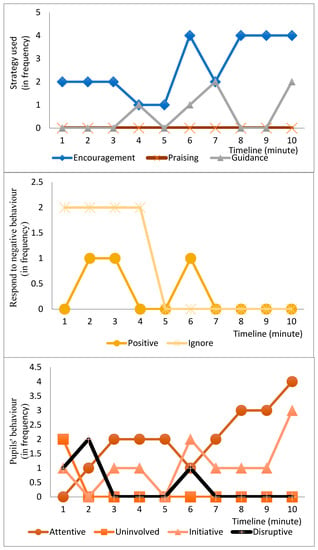
Figure A1.
Observed session 1 (Case Study School 1).
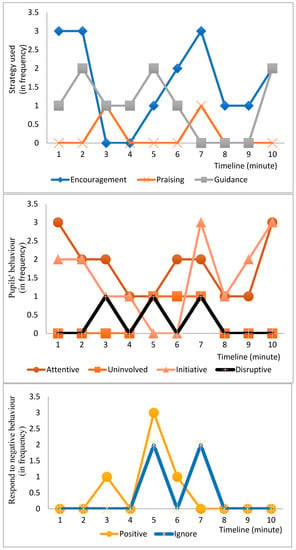
Figure A2.
Observed session 2 (Case Study School 1).
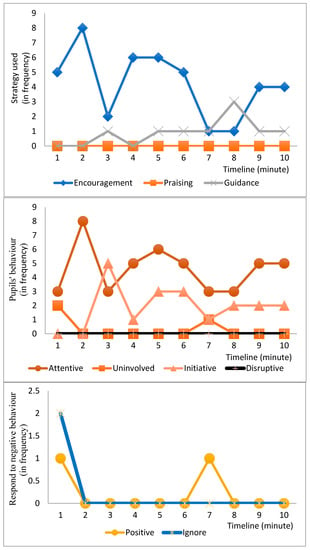
Figure A3.
Observed session 3 (Case Study School 1).
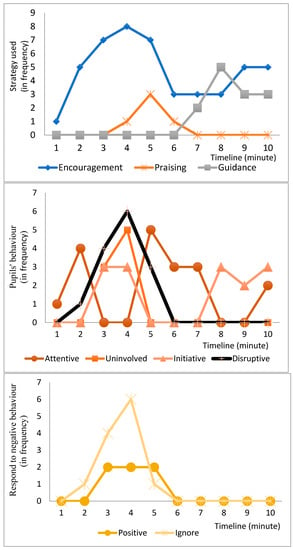
Figure A4.
Observed session 4 (Case Study School 1).
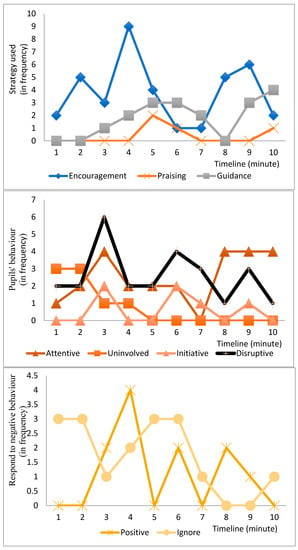
Figure A5.
Observed session 5 (Case Study School 1).
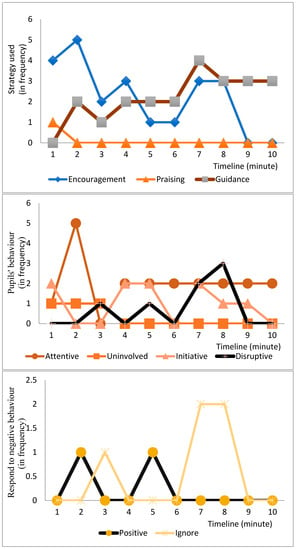
Figure A6.
Observed session 6 (Case Study School 1).
Appendix B. Observed Sessions from Case Study School 2
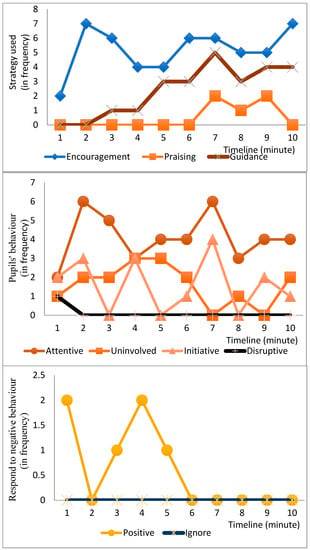
Figure A7.
Observed session 1 (Case Study School 2).
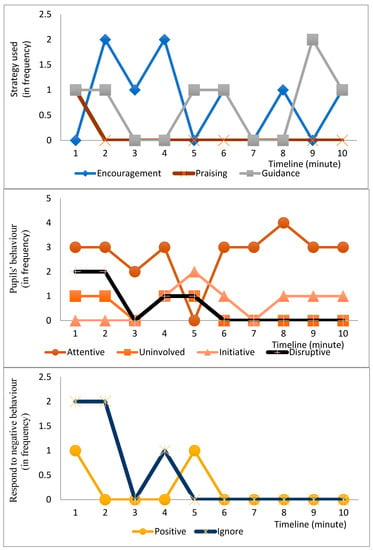
Figure A8.
Observed session 2 (Case Study School 2).
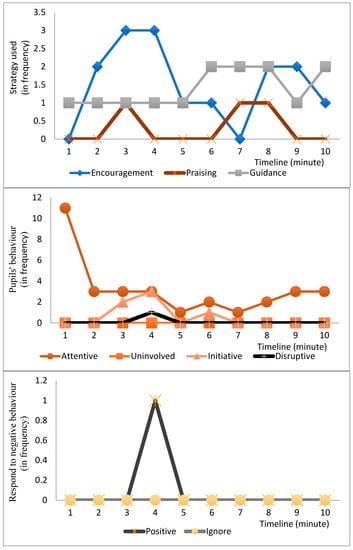
Figure A9.
Observed session 3 (Case Study School 2).
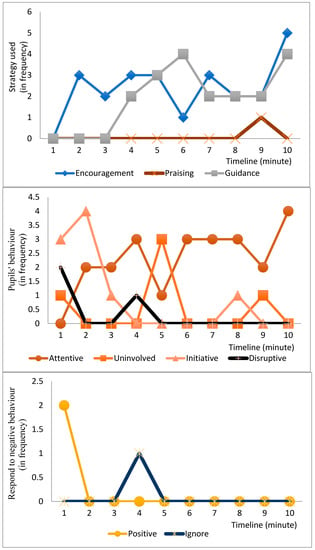
Figure A10.
Observed session 4 (Case Study School 2).
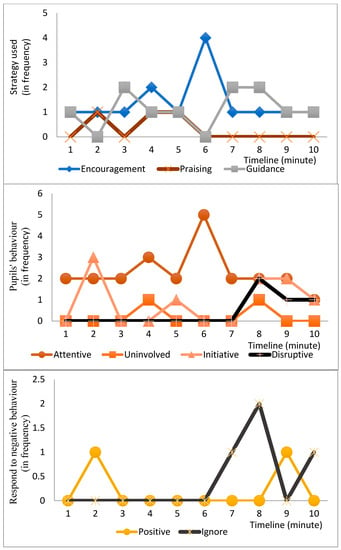
Figure A11.
Observed session 5 (Case Study School 2).
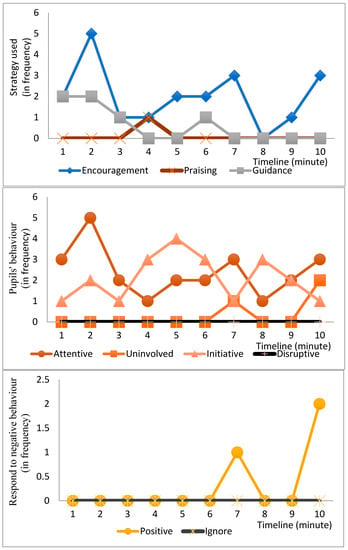
Figure A12.
Observed session 6 (Case Study School 2).
References
- Akman, Y. The role of classroom management on confidence in teachers and educational stress. Int. J. Contemp. Educ. Res. 2020, 7, 335–345. [Google Scholar] [CrossRef]
- Rezaei, G. Public Policy Line in Management. J. Educ. Res. 2019, 33, 37–52. [Google Scholar]
- Cansoy, R.; Polatcan, M.; Parlar, H. Research on Teacher Self-Efficacy in Turkey: 2000–2017. World J. Educ. 2018, 8, 133–145. [Google Scholar] [CrossRef] [Green Version]
- Ab Rahman, Z.; Kashim, M.I.A.M.; Mohd Noor, A.Y.; Che, Z.S.A.; Abdul Rahim Ridzuan, A.R.R.; Hanizah, M.; Yusoff, W. Critical review of positive behavior and resilience In islamic perspective during the COVID-19 pandemic. J. Crit. Rev. 2020, 7, 1117–1125. [Google Scholar]
- Abdul Kadir, N.B.; Aun, N.S.M.; Ibrahim, N.; Nor, H.A.; Johan, D. Do friendship attachment and positive and negative emotions encourage prosocial behavior among adolescents in Malaysia? Int. J. Psychosoc. Rehabil. 2020, 24, 4410–4420. [Google Scholar]
- Awang, M.M.; Jindal-Snape, D.; Barber, T. A Systematic Review of Theoretical Foundations for Pedagogical Strategies to Promote Positive Behavior. New Educ. Rev. 2019, 58, 133–143. [Google Scholar] [CrossRef]
- Singh, C.K.S.; Singh, T.S.M.; Ja’afar, H.; Tek, O.E.; Kaur, H.; Moastafa, N.A.; Yunus, M. Teaching strategies to develop higher order thinking skills in English literature. Int. J. Innov. Creat. Chang. 2020, 11, 211–231. [Google Scholar]
- Ahonen, A.; Rajala, R. Psycho-social Well-Being among School children in the Northern Areas of Finland, Sweden, Norway and North West Russia. In Proceedings of the Australian Association for Research in Education, Melbourne, Australia, 26–29 November 2007. [Google Scholar]
- Riley, P. An Adult Attachment Perspective on the Student–Teacher Relationship and Classroom Management Difficulties. Teach. Teach. Educ. 2009, 25, 626–635. [Google Scholar] [CrossRef]
- Ungar, M.; Tutty, L.M.; McConnell, S.; Barter, K.; Fairholm, J. What Canadian Youth Tell Us about Disclosing Abuse. Child Abus. Negl. 2009, 33, 699–708. [Google Scholar] [CrossRef]
- Infantino, J.; Little, E. Students’ Perceptions of Classroom Behaviour Problems and the Effectiveness of Different Disciplinary Methods. Educ. Psychol. 2005, 25, 491–508. [Google Scholar] [CrossRef]
- Petegem, K.V.; Aelterman, A.; Keer, H.V.; Rosseel, Y. The Influence of Student Characteristics and Interpersonal Teacher Behaviour in the Classroom on Student’s Wellbeing. Soc. Indic. Res. 2008, 85, 279–291. [Google Scholar] [CrossRef]
- Gillies, R.M.; Boyle, M. Teachers’ Reflections on Co-operative Learning: Issues of Implementation. Teach. Teach. Educ. 2010, 26, 933–940. [Google Scholar] [CrossRef]
- Torff, B.; Sessions, D.N. Principals’ Perceptions of the Causes of Teacher Ineffectiveness. J. Educ. Psychol. 2005, 97, 530–537. [Google Scholar] [CrossRef]
- Salleh, J.M.; Matore, M.E.E.M. Effective Teaching Index of Trust School Program (TSP) based on seven pedagogical pillars. Int. J. Grid Distrib. Comput. 2020, 13, 1261–1267. [Google Scholar]
- Ding, M.; Li, Y.; Li, X.; Kulm, G. Chinese Teachers’ Attributions and Coping Strategies for Student Classroom Misbehaviour. Asia Pac. J. Educ. 2010, 30, 321–337. [Google Scholar] [CrossRef]
- Kunter, M.; Baumert, J.; Koller, O. Effective Classroom Management and the Development of Subject-Related Interest. Learn. Instr. 2007, 17, 494–509. [Google Scholar] [CrossRef]
- Asada, T.; Uosaki, Y. A Study on the Mentoring System for Beginning Teacher. In Proceedings of the British Educational Research Association Annual Conference, University of Warwick, Warwickshire, UK, 6–9 September 2006. [Google Scholar]
- Shek, D.T.L.; Yu, L. Prevention of Adolescent Problem Behaviour: Longitudinal Impact of the Project P.A.T.H.S. in Hong Kong. Sci. World J. 2011, 11, 546–567. [Google Scholar] [CrossRef]
- Wearmouth, J.; Mckinney, R.; Glynn, T. Restorative Justice in Schools: A New Zealand Example. Educ. Res. 2007, 49, 37–49. [Google Scholar] [CrossRef]
- Silverman, D. Doing Qualitative Research; SAGE publication Ltd.: London, UK, 2005. [Google Scholar]
- Perrott, E. Effective Teaching: A Practical Guide to Improving Your Teaching; Longman: New York, NY, USA, 1982. [Google Scholar]
- Bakar, N.S.B.; Maat, S.M.; Rosli, R. Mathematics teachers self efficacy of technology integration and technological pedagogical content knowledge. J. Math. Educ. 2020, 11, 259–276. [Google Scholar] [CrossRef]
- Nuri, N.M.; Ali, M.M.; Salleh, N.M. Teachers knowledge, skills, and readiness in the guidance of self-advocacy skills to students with special needs. Int. J. Acad. Res. Progress. Educ. Dev. 2021, 10, 563–578. [Google Scholar]
- Bakara, A.Y.A.; Ahmadb, S.N.; Mahmudc, M.I. School guidance and counselling services for special education students in Malaysia: A literature review. Int. J. Innov. Creat. Chang. 2019, 5, 421–433. [Google Scholar]
- Albrecht, S.F. Time Away: A Skill-building Alternative to Discipline. Prev. Sch. Fail. 2008, 53, 49–55. [Google Scholar] [CrossRef]
- Dupper, D.R. Does the Punishment Fit the Crime? The Impact of Zero Tolerance Discipline on At-risk Youths. Child. Sch. 2010, 32, 67–70. [Google Scholar] [CrossRef]
- Drewry, J.A.; Burge, P.L.; Driscoll, L.G. A Tripartite Perspective of Social Capital and Its Access by High School Dropouts. Educ. Urban Soc. 2010, 42, 499–521. [Google Scholar] [CrossRef]
- Dunbar, C. Best Practices in Classroom Management; Jackson, L.C., Ed.; Michigan State University: East Lansing, MI, USA, 2004; p. 32. [Google Scholar]
- Dunlap, G.; Carr, E.G.; Horner, R.H.; Zarcone, J.R.; Schwartz, I. Positive Behaviour Support and Applied Behaviour Analysis: A Familial Alliance. Behav. Modif. 2008, 32, 682–698. [Google Scholar] [CrossRef]
- Jerry, M.; Yunus, M.M. Blended learning in rural primary ESL classroom: Do or don’t. Int. J. Learn. Teach. Educ. Res. 2021, 20, 152–173. [Google Scholar] [CrossRef]
- Padzil, M.R.; Karim, A.A.; Husnin, H. Employing ddr to design and develop a flipped classroom and project based learning module to applying design thinking in design and technology. J. Adv. Comput. Sci. Appl. 2021, 12, 791–798. [Google Scholar] [CrossRef]
- Kiang, N.H.; Yunus, M.M. What do Malaysian ESL teachers think about flipped classroom? Int. J. Learn. Teach. Educ. Res. 2021, 20, 117–131. [Google Scholar] [CrossRef]
- Song, S.J.; Tan, K.H.; Awang, M.M. Generic Digital Equity Model in Education: Mobile-Assisted Personalized Learning (MAPL) through e-Modules. Sustainability 2021, 13, 11115. [Google Scholar] [CrossRef]
- Jennifer, W.B.N.; Sharifah, M.N.; Zakaria, K.; Fooi, F.S. Models of School-family Partnership: The Malaysian Context Pertanika. J. Soc. Sci. Hummanities 2001, 9, 36–47. [Google Scholar]
- Ministry of Education Malaysia. Professional Circular: Prevention of Gangster Activities (2); Ministry of Education Malaysia: Kuala Lumpur, MY, USA, 1998.
- Vincent, C.G.; Randall, C.; Cartledge, G.; Tobin, T.J.; Swain-Bradway, J. Toward a Conceptual Integration of Cultural Responsiveness and Schoolwide Positive Behaviour Support. J. Posit. Behav. Interv. 2011, 13, 219–229. [Google Scholar] [CrossRef] [Green Version]
- Dunlop, A.-W. Bridging Research, Policy and Practice. In Informing Transitions in the Early Years—Research, Policy and Practice; Dunlop, A.-W., Fabian, H., Eds.; Open University Press: Berkshire, UK, 2007; pp. 151–168. [Google Scholar]
- Ferguson, M. Praise: What Does the Literature Say? What Are the Implications for Teachers? Kairanga 2013, 14, 35–39. [Google Scholar]
- Sklar, C.W. Fostering Prosocial Behaviours in Urban Elementary Schools: A Closer Look at the Montessori Approach. Doctor of Education Dissertation; University of Pennsylvania: Philadelphia, PA, USA, 2007. [Google Scholar]
- Carroll-Lind, J. I Must Respect My Teacher, I Must Respect My Teacher, I Must Respect My Teacher: The Merits of Giving Out Lines as a Punishment. N. Z. J. Teach. Work 2005, 2, 94–99. [Google Scholar]
- Hue, M.-T. The Relationships between School Guidance and Discipline: Critical Contrasts in Two Hong Kong Secondary Schools. Educ. Rev. 2007, 59, 343–361. [Google Scholar] [CrossRef]
- Ybrandt, H. The Relation between Self-concept and Social Functioning in Adolescence. J. Adolesc. 2008, 31, 1–16. [Google Scholar] [CrossRef]
- Schedin, G. Similarity of Interpersonal Behaviour in Career Counselling. Int. J. Educ. Vocat. Guid. 2005, 5, 37–55. [Google Scholar] [CrossRef]
- Tina, A.; Irvine, G. The Impact of Challenging Student Behaviour upon Teachers Lives in a Secondary School: Teachers Perceptions. Br. J. Spec. Educ. 2008, 35, 144–151. [Google Scholar]
- Obenchain, K.M.; Taylor, S.S. Behaviour Management: Making It Work in Middle and Secondary. Clear. House A J. Educ. Strateg. Issues Ideas 2005, 79, 7–11. [Google Scholar] [CrossRef]
- Awang, M.M.; Alfitri, A.; Ahmad, A.R.; Careemdeen, J.D.; Ahmad, J. Socio-Ecological Support and Physical Facilities Satisfaction: How They Link to Social Participation and Well-Being among Urban Residents in Malaysia. Sustainability 2022, 14, 1184. [Google Scholar] [CrossRef]
- Alakrash, H.M.; Abdul Razak, N. Technology-Based Language Learning: Investigation of Digital Technology and Digital Literacy. Sustainability 2021, 13, 12304. [Google Scholar] [CrossRef]
Publisher’s Note: MDPI stays neutral with regard to jurisdictional claims in published maps and institutional affiliations. |
© 2022 by the authors. Licensee MDPI, Basel, Switzerland. This article is an open access article distributed under the terms and conditions of the Creative Commons Attribution (CC BY) license (https://creativecommons.org/licenses/by/4.0/).